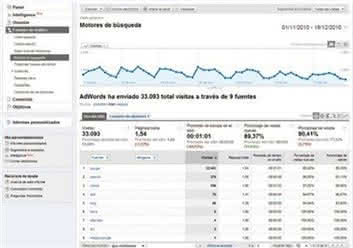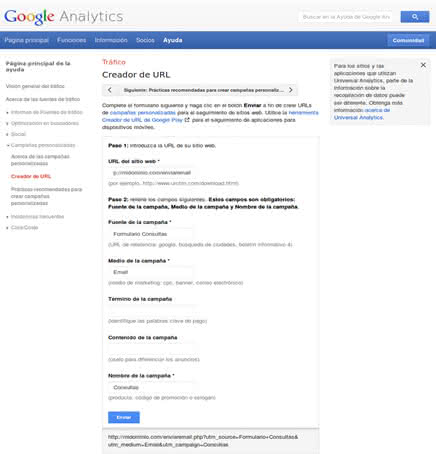Who makes a website knows that it must have the best position in the search engines to get users or visitors, for it the Search Engine Optimization known as SEO and the Marketing in search engines known as SEM are two of the essential elements nowadays for a full strategy of online marketing, especially if we talk about a search engine optimization strategy.
Combining SEO and SEM strategies will improve search engine marketing we can achieve great results.
It is estimated that approximately ads paid as Adword campaigns could increase the ranking of organic results gradually in an estimate of 89%.
In the case of search engines there are 2 types of searches, the organic natural SEO and the SEM pay. SEO must take into account both types of search, paid and organic, in the design of a search engine marketing strategy, to get an accurate view of the entire marketing environment.
What are the metrics for?
- . Determine what users who come from the search engines do, if they buy, if they manage to meet the objectives of your site (Conversions) .
- Determine if the search of the users and know how to adapt it in your strategy, contents, architecture (Web optimization)
- To learn to make decisions based on data and not on intuition.
- Know the user's tastes over those of the designer.
The metrics are understood to be taken from Google Analytics or Adword estimates, some metrics are: 1) Know the CTR Paid Click Percentage
To do it in a generic way: Select search terms through the payment and organic results, add the total clicks, then calculate the clicks paid as a percentage of that total. To consult and perform these analyzes are Google Analytics and Google Adword.

For example, we can consult the percentages of clicks paid over 75% to identify the keywords that are receiving fewer clicks on organic results and thus work on organic strategies or SEM.
2) Time spent on the web (bounce rate)
It's a Google Analytics metric that measures the number of visits they leave when they see only one page
It is important to keep visitors as long as possible, if the bounce rate is higher than 40% the website has little interest or the user does not find what they are looking for and does not browse our website. This is what most affects many web.
Here are some tips and tricks to lower the rebound rate.
Tips to lower the Rebound Percentage:
- Provide content, keywords and relevant titles for the user
- It offers a clear and simple way to navigate through your site.
- Add related ticket links.
- Make your page load faster by improving the design making it lighter.
- Avoid pop-up ads, or heavy animations.
- External links make them open on a new page and avoid iframes
3) Keywords that generate traffic
If you have not done SEO on the website, surely we will realize this because most keywords that have visits to the page, be the name of your company or the domain of the web. This is good, it means that the users know the name of the company or that the web exists and they look for it, for example when you go Google you do not put "internet search engines" as a keyword. Well, the company is well known and writes direct domain. Therefore, promoting the domain and the brand is also important.
4) Traffic and conversion indicators
They allow us to generate custom metrics like for example
- How many queries have been sent from a form on the web?
- How many users request a product and how much a service?
- How many candidates register for a course?
- How many tickets will an event sell?
All these personalized metrics are not by default since no business is the same as another and each one must adapt its online marketing plan. To do this we will use a tool to create personalized links (url), so when the user performs the action of clicking on those links we can give it a meaning and measure it.
It depends on which page we put the link we will know what action the user made. Example if I want to know how many consultations the user has made I will put the link when the user clicks to send the form.
With the URL Creator
Here we will create a URL to measure how many times a query form is sent, but it could be used to measure sales, subscriptions or whatever we would like.

The following parameters of the tool are completed:
- Domain: http://midominio.com/enviarmail (page where the action takes place)
- Campaign Source: Queries form (from where the action will take place)
- Campaign medium: Email (how the action is sent or received)
- Term of the campaign: if I use a keyword, in this case
- Content of the campaign: to differentiate where the web action comes from, mobile
- Name of the campaign: name to differentiate different measurements
This is our example link http: //midominio.com...paign=Consultas
5) Local Search Reports
Google Analytics has recently made significant improvements to its local search capabilities and has a separate report capability for local traffic and metrics.
Maybe you discover that the business receives many visits from another city and you can do marketing there
6) Interactions in Social Networks
Users can meet us interacting in social networks such as Facebook, Google plus or Twitter and generate marketing campaigns on these platforms.
Comments, I like you, shared publications, tweets and retweets or +1 are factors that of course play in favor of the positioning of a website and the activity and traffic that can be generated.
7) External links (backlink): that other websites mention or link us
The strategies for another prestigious website to link or talk about our website, can be a great ally. That is why it is essential to take care of this aspect, increase the number of these backlinks and bet on quality, then you can measure Google Analytics in Sources> Reference, the amount of click provided by these external links.
How to avoid miscalculating or making mistakes with SEO or SEM metrics
Do not be aware of the metrics all the time, that if the website is on the first or third page of Google, or under 0.5% the percentage rebound. Compare the evolution in time, at least, every 3 months and comparisons with the previous year, see the metrics every day will not be useful changes in SEO position impact on search engines every 45 or 90 days.
Put an achievable goal, pretend to be first and have the best metrics with a 10-day campaign will not do any good and less if you put a budget in Adword to increase visits quickly, as we said at the beginning can rise 89% immediately and thus fall the metrics along with the visits also when you stop campaigning pay. The paid campaign must be accompanied by a long-term organic campaign.